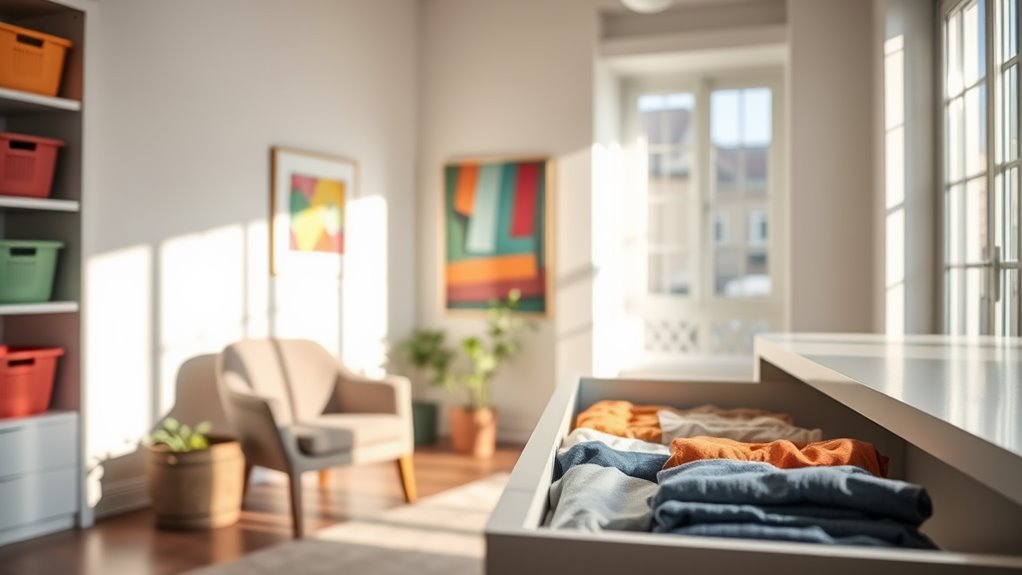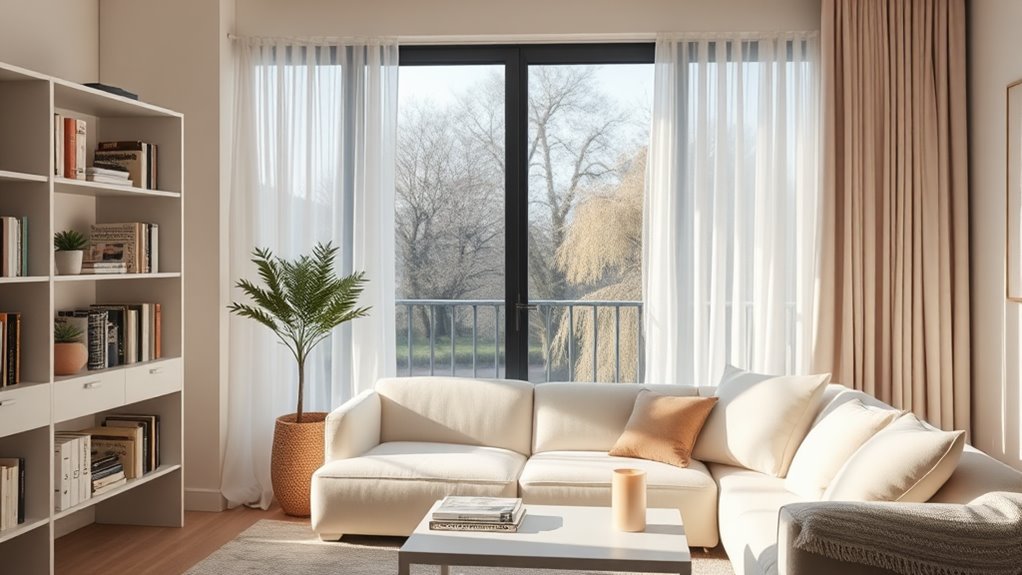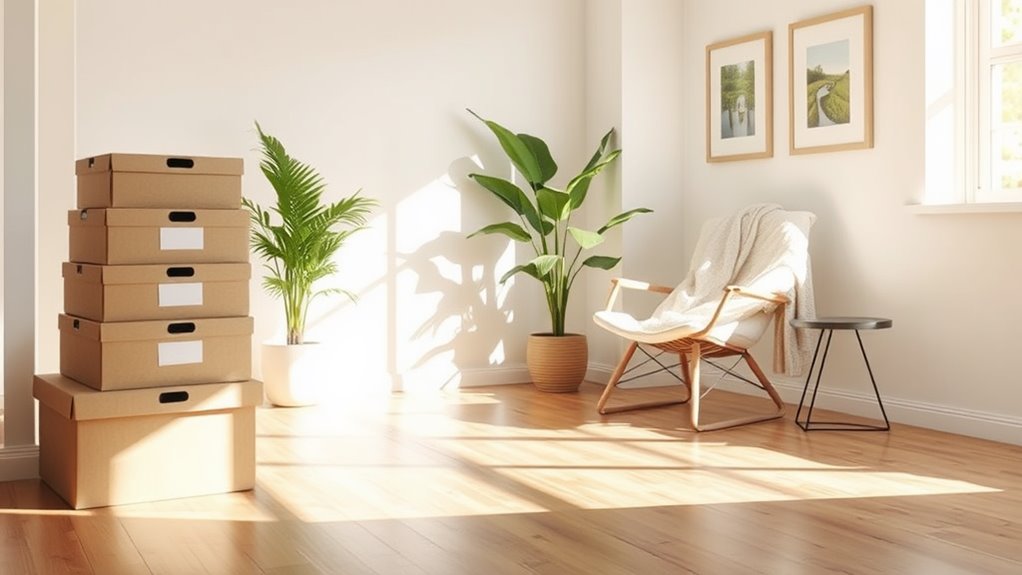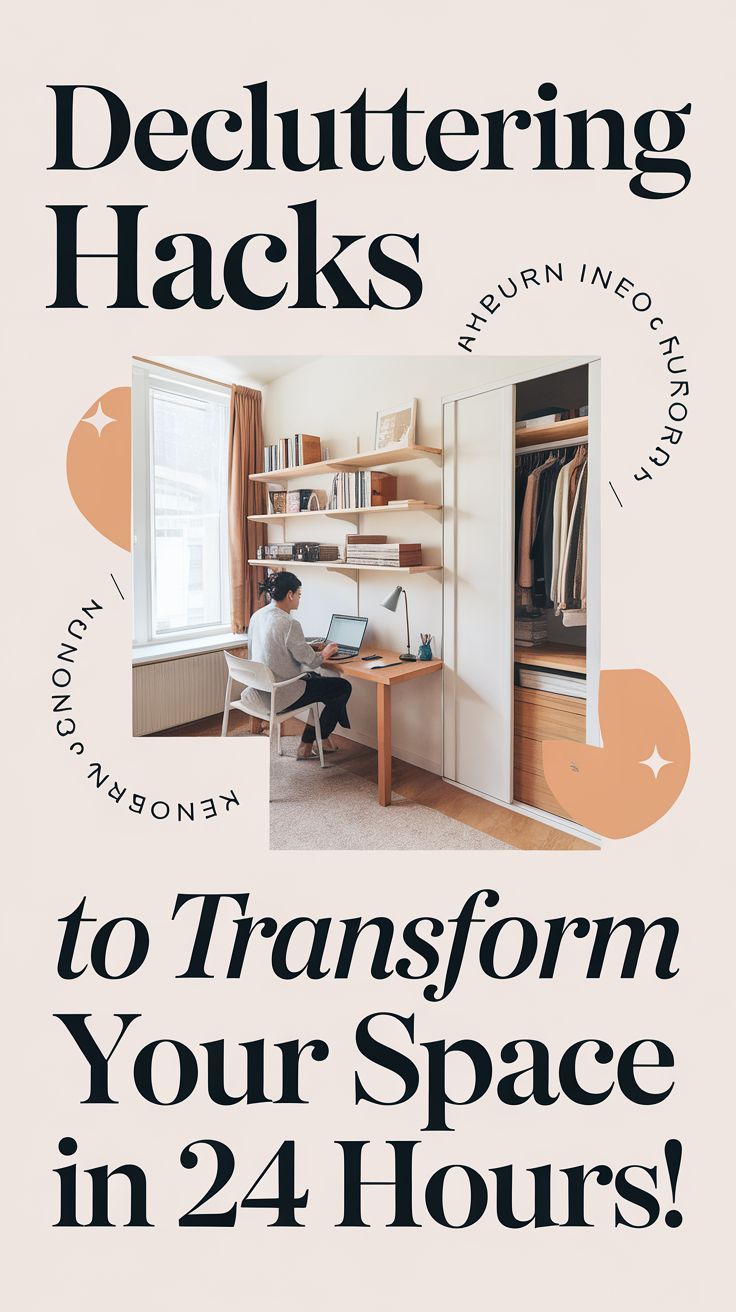Decluttering Hacks That Are Changing Lives!
If you’re looking for decluttering hacks that change lives, start with the 30-Day Declutter Challenge. It breaks tasks into manageable daily goals, making it easier to stay on track. Embrace a minimalist mindset by valuing experiences over possessions. Tackle your space room by room, focusing on what’s essential and joyful. Utilize smart storage solutions like under-bed bins and wall-mounted shelves to maximize space. Don’t forget about digital clutter—organize your emails for a clearer mind. Establish daily tidying habits to maintain your progress. These practical strategies can make a real difference, and there’s even more to explore on this journey.
Key Takeaways
- Implement the 30-Day Declutter Challenge to tackle one small area daily, building momentum and celebrating achievements along the way.
- Adopt a minimalist mindset by prioritizing experiences over possessions and evaluating items based on their purpose and joy.
- Schedule short, focused decluttering sessions of 15-30 minutes to prevent overwhelm and maintain consistent progress.
- Utilize creative storage solutions like under-bed bins and wall-mounted shelves to maximize space without sacrificing style.
- Regularly assess belongings through seasonal decluttering check-ins to maintain a clutter-free environment and ensure intentional consumption.
The 30-Day Declutter Challenge
Ready to transform your space? The 30-Day Declutter Challenge is your roadmap to a more organized life. Each day, you’ll tackle a specific area, eliminating excess and creating clarity. Start by grabbing a 30-day planner to outline your tasks. This structured approach keeps you focused and accountable.
On Day 1, pick a small space—like a drawer or a shelf. On Day 2, move to a closet or a larger area. By breaking it down, you’ll avoid overwhelm and build momentum. Use declutter motivators like the “one in, one out” rule: for every new item you bring home, let go of an old one.
As you progress, celebrate your wins. This not only reinforces your commitment but also keeps you inspired. You’ll discover that letting go of items you no longer need creates emotional and physical space for what truly matters.
Stay consistent and remember, the goal isn’t perfection; it’s progress. By the end of the month, you’ll have transformed your environment, making it more functional and serene.
Minimalist Mindset Shift
Embracing a minimalist mindset can greatly enhance your decluttering journey. This shift in perspective aligns with the minimalist philosophy, which emphasizes valuing experiences over possessions. When you adopt this mindset, you’re not just clearing out clutter; you’re making room for intentional living.
Start by evaluating what truly matters to you. Ask yourself, “Does this item serve a purpose or bring me joy?” If it doesn’t, it’s time to let it go. This practice helps you prioritize quality over quantity, enabling you to curate a space that reflects your values and aspirations.
Another important aspect is to recognize that decluttering isn’t a one-time event; it’s a continuous process. By committing to a minimalist mindset, you’ll find that each decision becomes easier, and you’ll develop a clearer understanding of your needs.
Consider setting specific intentions for your space and lifestyle. This allows you to align your belongings with your goals, making it easier to resist the urge to accumulate more.
Ultimately, embracing a minimalist mindset will lead to a more fulfilling, organized, and intentional life, transforming not just your space but your overall well-being.
Room-by-Room Decluttering Strategies
Adopting a minimalist mindset sets the stage for effective room-by-room decluttering strategies.
Start with your wardrobe; a wardrobe overhaul can transform not just your space but also your daily routine. Pull everything out, categorize by type—tops, bottoms, accessories—and evaluate each piece. If it doesn’t spark joy or serve a purpose, it’s time to let it go.
Next, tackle the kitchen. A kitchen refresh can increase your efficiency and joy in cooking. Begin by emptying cabinets and drawers. Check expiration dates on food items, and dispose of anything that’s past its prime. Organize utensils and gadgets by frequency of use, ensuring that your most-used items are easily accessible.
For each room, consider a “one in, one out” rule to prevent clutter from building up again. Set a timer for short, focused sessions—15 to 30 minutes—to keep the process manageable and less overwhelming.
Storage Solutions You Need
When it comes to creating a clutter-free environment, effective storage solutions are essential for maximizing your space and keeping everything organized. You don’t need to sacrifice style for functionality; integrating creative storage and multifunctional furniture can transform your space. Here are some practical options to evaluate:
| Storage Solution | Description | Benefits |
|---|---|---|
| Under-Bed Storage Bins | Utilize the space under your bed | Keeps items out of sight, accessible |
| Wall-Mounted Shelves | Install shelves for books and decor | Saves floor space, adds visual interest |
| Ottoman with Storage Inside | Use an ottoman that opens for storage | Dual-purpose seating and storage |
| Floating Cabinets | Install cabinets that don’t touch the floor | Creates an airy feel, enhances room functionality |
Digital Decluttering Techniques
It’s easy to feel overwhelmed by the digital clutter in your life. Organizing your email inbox and streamlining your digital files can make a big difference in your productivity and peace of mind.
Let’s explore some effective techniques to help you regain control over your digital space.
Organizing Email Inboxes
Regularly organizing your email inbox can greatly reduce stress and improve productivity. To achieve an effective system, start by establishing an email hierarchy. Categorize your emails into folders or labels such as “Urgent,” “To Read,” and “Archive.” This structure allows you to quickly identify what needs your immediate attention and what can wait.
Aim for inbox zero, a state where your inbox contains only actionable emails. To reach this goal, set aside time daily or weekly to process your emails. Delete unnecessary messages, respond to those that require quick replies, and move others to the appropriate folders.
You can also utilize filters and rules to automate this process, helping to keep your inbox organized without constant manual effort. Consider using tools or apps that integrate with your email to enhance your organization. These can remind you of pending tasks or deadlines associated with your emails.
Streamlining Digital Files
Managing your email inbox sets a solid foundation for further digital organization, but streamlining your digital files is equally important. Start by evaluating your current file management system. Identify unnecessary files, duplicates, and outdated documents that clutter your storage. Use a consistent naming convention for your files to simplify searching and retrieval.
Next, categorize your files into clearly defined folders. This could include work documents, personal files, or project-specific folders. Organization is key, so make certain that each category is intuitive and easy to navigate.
Consider utilizing cloud storage solutions for enhanced accessibility and security. Platforms like Google Drive or Dropbox not only free up local storage but also allow for easy collaboration and sharing. Make it a habit to regularly back up important files in the cloud, making sure you never lose crucial information.
Finally, set aside time weekly or monthly to review and clean up your files. Regular maintenance prevents digital clutter from building up again, keeping your virtual space as organized as your physical one.
Seasonal Decluttering Tips
As the seasons change, so does the opportunity to refresh your living space through seasonal decluttering. Each season presents a unique chance to assess what you really need and what can go.
Start with spring cleaning; it’s not just a tradition, but an essential practice for maintaining a harmonious home. Dedicate a weekend to tackle one room at a time, focusing on closets, storage spaces, and surfaces. Ask yourself if each item serves a purpose or brings joy. If it doesn’t, consider donating or selling it.
As you approach the end of the year, holiday prep becomes crucial. Evaluate decorations and holiday-specific items. Are you holding onto things that no longer resonate with your current style?
This is the perfect time to sort through those items. Create a designated bin for what you’ll use this year and discard the rest.
Maintenance Habits for Longevity
To keep your space clutter-free, establishing a few maintenance habits is essential.
Start by incorporating a daily tidying routine, and schedule seasonal check-ins to reassess your belongings.
Additionally, practicing mindful consumption can help you avoid unnecessary purchases that lead to clutter in the first place.
Daily Tidying Routine
Often, a consistent daily tidying routine can make all the difference in maintaining a clutter-free environment. By integrating simple daily habits into your life, you can transform your space without feeling overwhelmed. Start small: dedicate just 10-15 minutes each day to quick tasks that keep clutter at bay.
Begin by creating a “drop zone” near your entryway for items like keys, bags, and mail. This prevents them from spreading throughout your home. Next, tackle one area at a time—perhaps a single countertop or shelf. Use the “one in, one out” rule: for every new item you bring in, let go of one you no longer need.
Incorporate quick tasks into your routine, like making your bed each morning or putting dishes away after meals. These actions not only tidy your space but also set a positive tone for your day.
At the end of the day, take a few minutes to assess your surroundings. Put away any stray items that have accumulated. By committing to these daily habits, you’ll find that maintaining order isn’t just achievable but sustainable, paving the way for a serene home environment.
Seasonal Decluttering Check-ins
At the change of each season, it’s a great opportunity to reassess your space and tackle any accumulated clutter.
Creating a declutter calendar can help you stay organized and focused on your seasonal goals. Start by scheduling dedicated time for each area of your home, guaranteeing you don’t overlook any spaces.
Begin with the most clutter-prone areas, like closets and storage rooms. As you sort through items, ask yourself if they still serve a purpose or bring you joy. If not, it’s time to let them go.
Next, categorize your belongings into keep, donate, and discard piles. This method not only streamlines the process but also clears your mind as you see tangible progress.
Remember to be ruthless; if an item hasn’t been used in the past year, it’s probably safe to say goodbye.
Finally, don’t forget to maintain your decluttering momentum throughout the season. Set reminders on your declutter calendar for quick check-ins to guarantee clutter doesn’t creep back in.
Mindful Consumption Practices
Maintaining an organized space goes hand-in-hand with adopting mindful consumption practices.
By being intentional about what you bring into your life, you can create a harmonious environment that reflects your values and needs.
Here are three strategies to enhance your mindful consumption:
-
Intentional Purchasing: Before buying, ask yourself if the item aligns with your lifestyle and values. Prioritize quality over quantity to guarantee longevity.
-
Mindful Gifting: When choosing gifts, consider the recipient’s interests and needs. Opt for experiences or handmade items that foster meaningful connections rather than material excess.
-
Conscious Decluttering: Regularly assess what you own. If something no longer serves a purpose or brings joy, consider donating or recycling it.
Frequently Asked Questions
How Do I Motivate Myself to Start Decluttering?
Starting decluttering’s like standing before a mountain; intimidating yet conquerable. Break it down into small, achievable goals. Tackle one area at a time, and soon those decluttering challenges will transform into triumphs you can celebrate.
What Should I Do With Sentimental Items?
When dealing with sentimental items, prioritize emotional attachment. Consider creating a sentimental storage box for cherished pieces. Evaluate each item’s significance, keeping only what truly resonates with you, and let go of the rest.
Can Decluttering Improve My Mental Health?
Yes, decluttering can greatly improve your mental health. By reducing clutter, you gain mental clarity, allowing you to focus better and feel less overwhelmed. Embracing decluttering benefits can lead to a more organized, peaceful life.
How Do I Maintain My Decluttered Space Long-Term?
How can you maintain a decluttered space long-term? Embrace daily routines that reinforce a minimalist mindset. Regularly assess your belongings, prioritize essentials, and create habits that foster organization, ensuring your space remains serene and functional.
Is There a Right Time to Declutter?
There’s no one-size-fits-all answer, but seasonal shifts and significant life events are great opportunities to declutter. You’ll find it easier to reassess your belongings when changes naturally prompt you to evaluate your space.




